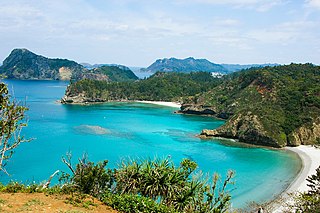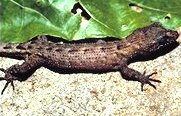
Gekkonidae is the largest family of geckos, containing over 950 described species in 64 genera. Members of the Gekkonidae comprise many of the most widespread gecko species, including house geckos (Hemidactylus), tokay geckos (Gekko), day geckos (Phelsuma), mourning geckos (Lepidodactylus) and dtellas (Gehyra). Gekkonid geckos occur globally and are particularly species-rich in tropical areas.

Perochirus is a genus of geckos endemic to the Philippines, Oceania and Japan, commonly known as Micronesian geckos, Polynesian geckos, or tropical geckos.

The Ogasawara subtropical moist forests is a terrestrial ecoregion which encompasses the Ogasawara Archipelago of Japan. The Ogasawara Archipelago lies in the Pacific Ocean south of Honshu, Japan's largest island, and north of the Marianas Islands. The ecoregion includes the Bonin Islands and Volcano Islands chains. The islands are volcanic in origin, and have never been linked to a continent. They are home to distinct plants and animals including many endemic species.

The white-bellied spider monkey, also known as the white-fronted or long-haired spider monkey, is an endangered species of spider monkey, a type of New World monkey. It is found in the north-western Amazon in Colombia, Ecuador, Venezuela, Peru and Brazil, ranging as far south as the lower Ucayali River and as far east as the Branco River. In the past, the Peruvian, brown and white-cheeked spider monkeys have been treated as subspecies of A. belzebuth. As presently defined, the white-bellied spider monkey is monotypic. It has a whitish belly and a pale patch on the forehead, which, despite its common name, often is orange-buff. They live in groups of 20 to 40 individuals, splitting into small parties of 1 to 9 when in activity.

The red-faced spider monkey also known as the Guiana spider monkey or red-faced black spider monkey, is a species of spider monkey found in the rain forests in northern South America.

Geoffroy's spider monkey, also known as the black-handed spider monkey or the Central American spider monkey is a species of spider monkey, a type of New World monkey, from Central America, parts of Mexico and possibly a small portion of Colombia. There are at least five subspecies. Some primatologists classify the black-headed spider monkey, found in Panama, Colombia, and Ecuador as the same species as Geoffroy's spider monkey.

The Peruvian spider monkey also known as the black-faced black spider monkey, is a species of spider monkey that lives in Peru, as well as in Brazil and in Bolivia. At 60 centimetres long, they are relatively large among species of monkey, and their strong, prehensile tails can be up to 1 m (3 ft) long. Unlike many species of monkey, they have only a vestigial thumb, an adaptation which enables them to travel using brachiation. Peruvian spider monkeys live in groups of 20–30 individuals, but these groups are rarely all together simultaneously. The size and dynamics of the resulting subgroups vary with food availability and sociobehavioral activity. They prefer to eat fleshy fruit, but will change their diet in response to scarcity of ripe fruit. Individuals of this species also eat small animals, insects and leaves based on availability. Females separate from the band to give birth, typically in the fall. These females inhabit a group of core areas where resources are abundant in certain seasons. Typically, males exhibit ranging over longer distances than females, with movement of individuals enhancing the fluidity of subgroup size. Peruvian spider monkey are independent at about 10 months, with a lifespan of about 20 years.

The black-headed spider monkey is a type of New World monkey, from Central and South America. It is found in Colombia, Ecuador, and Panama. Although primatologists such as Colin Groves (1989) follow Kellogg and Goldman (1944) in treating A. fusciceps as a separate species, other authors, including Froelich (1991), Collins and Dubach (2001) and Nieves (2005) treat it as a subspecies of Geoffroy's spider monkey.

Cophixalus ateles is a species of frog in the family Microhylidae. It is endemic to Papua New Guinea. Its natural habitat is tropical moist lowland forests.

The oceanic flycatcher is a species of bird in the family Monarchidae. It is endemic to Micronesia and can be found on the Caroline Islands.

The ornate spider monkey, is a subspecies of Geoffroy's spider monkey, a type of New World monkey, from Central America, native to Costa Rica and Panama. Other common names for this subspecies include the brilliant spider monkey, the common spider monkey, the red spider monkey, the Panama spider ape, and the Azuero spider monkey; the latter two of which were previously thought to be distinct subspecies, panamensis and azuerensis, respectively.

The Yucatan spider monkey is a disputed subspecies of Geoffroy's spider monkey, and is one of the largest types of New World monkey. It inhabits Mexico, Guatemala and Belize. It is a social animal, living in groups of 20-42 members.

The Pohnpei kingfisher is a species of bird in the family Alcedinidae. It is endemic to Pohnpei. Its natural habitat is subtropical or tropical moist lowland forests. It was formerly considered to be a subspecies of the Micronesian kingfisher.
Lepidodactylus moestus is a species of gecko. It is found in the Marshall Islands, Federated States of Micronesia, and Palau.
The Mortlock Islands scaly-toed gecko is a species of gecko. It is endemic to Toimon Island in the Federated States of Micronesia.

Nactus pelagicus is a species of lizard in the family Gekkonidae. It is also known as the Pacific slender-toed gecko, pelagic gecko, and rock gecko. It is found from the Kai Islands through New Guinea, Melanesia and into the central Pacific, Micronesia, Tuamotu Archipelago, Fiji, Rotuma, Samoa, Solomon Islands, New Caledonia, Loyalty Islands, Vanuatu, Cook Islands, Tonga, Queensland in Australia, Northern Mariana Islands, and Guam.
Perochirus guentheri, also known as Gunther's tropical gecko or Vanuatu saw-tailed gecko, is a species of lizard in the family Gekkonidae. It is endemic to Vanuatu.
Perochirus scutellatus, also known as the shielded tropical gecko or atoll giant gecko, is a species of lizard in the family Gekkonidae. It is endemic to Micronesia.














